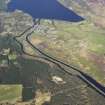Cille-chuimein
Cemetery (Period Unassigned)
Site Name Cille-chuimein
Classification Cemetery (Period Unassigned)
Canmore ID 12204
Site Number NH30NE 2
NGR NH 3781 0801
Datum OSGB36 - NGR
Permalink http://canmore.org.uk/site/12204
- Council Highland
- Parish Boleskine And Abertarff
- Former Region Highland
- Former District Inverness
- Former County Inverness-shire
NH30NE 2 3781 0801.
(NH 3781 0801) Cille-Chuimein (Burial Ground) (NAT)
OS 6"map, Inverness-shire, 2nd ed., (1904)
A grave yard, about 200 years old; people are still interred in it. The oldest tomb stone in it is about 170 years old. There was never a church in or nearer it than the Church of Fort Augustus (about 1 mile away). Its name originated from a chief of the Cummin or Comyns being buried there.
Name Book 1871
This grave yard is still in use, and contains grave stones dating back to the early 18th century. There are no traces of a church.
Visited by OS (N K B) 28 April 1964
This burial ground bears a name which suggests the former existence of a church dedicated to Cummein, Abbot of Iona, who died in 669. His 'seat', 'Suidhe Chuimein' lies at NH 449 105. (W J Watson 1926)
The nearby village, now Fort Augustus, and the parish were both formerly named Kilchuimin, obviously from this site.
Until 1614 Kilchuimin was an independent parish (H Scott 1926), presumably with a parish church, but about 1630 there was no trace of a church in this graveyard, although the site is referred to as "ane Church toune". This, together with the finding of medieval cists at NH 379 089 (NH30NE 7), could suggest the moving of the church and graveyard to a more convenient spot in the medieval period, but with
the old graveyard not falling completely out of use, and still retaining its former name.
W Macfarlane 1907
















